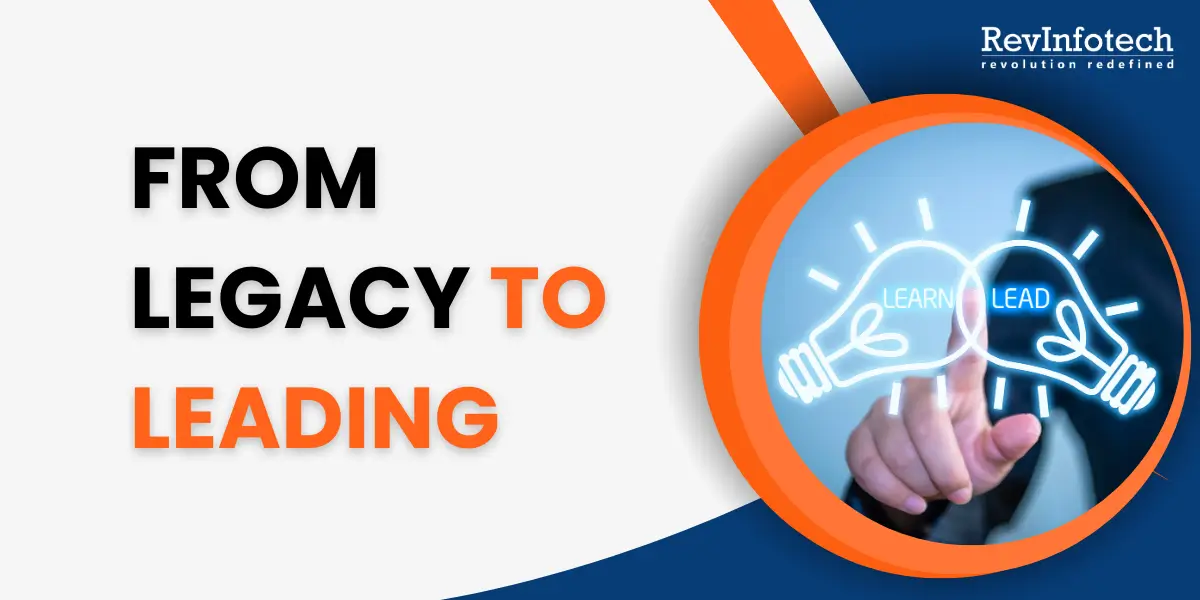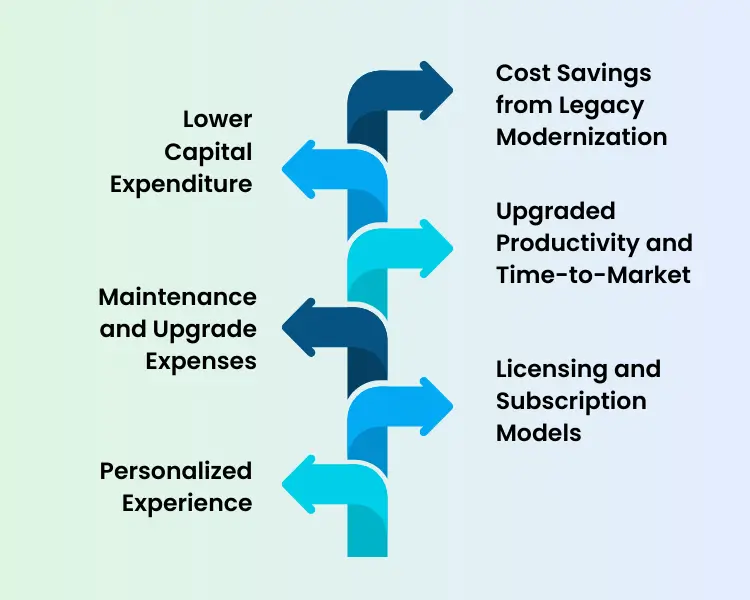Face it, cloud transformation is no longer an IT buzzword bandied about in the boardroom. For big companies, it’s now a survival step to remain relevant, nimble, and competitive. Migrating from legacy infrastructure to the cloud is not merely about changing your technology, it’s about reimagining how your entire enterprise operates, collaborates, and grows in a digital-first economy.
Consider it: those clunky, antiquated systems that used to drive your business now feel more like bottlenecks than assets. They hold things back, cost an arm and a leg to support, that further cause innovation to feel like a pipe dream. But when enterprise corporations make the move and go cloud-based, they’re not only in performance, but are in whole new avenues of growth, velocity, and customer delight.
Here in this blog, we will discuss what actually goes into making big businesses transition from legacy to leading with the cloud. We will dissect the challenges, showcase real-world success stories, and provide you with a crystal-clear roadmap to begin your own transformation process, jargon-free and with lots of practical learnings. Are you ready to level up?
What are the Best Practices For a Phased Cloud Rollout?
Phased cloud deployment is a tactical strategy to allow large enterprises to roll out to the cloud in steps without interrupting day-to-day business. The first best practice is to begin with a small footprint and scale intelligently. Choosing non-mission-critical workloads or pilot apps for the first phase allow teams to try out cloud performance, confirm architecture choices, and gain internal trust. This phase yields useful lessons that can be carried forward to subsequent phases, saving risk and increasing efficiency.
Another important practice is creating a business-priority-based roadmap. Not all systems are necessary to move to the cloud all at once, or even at all. Applications must be evaluated in terms of complexity, performance requirements, and expense. This guarantees cloud migration aligns with actual business value, not technical ease. A second benefit is ensuring IT and business stakeholders are aligned from the start to guarantee that organisational objectives remain at the forefront of every stage.
Finally, a helpful phased launch should be considered greater than a migration, it’s a stepping stone to enterprise modernization. Every phase should be utilized as an ability to maximise systems, refactor legacy processes, and upgrade collaboration across teams through cloud-native tools. Through ongoing feedback loops and performance assessments following every stage, enterprises can remain agile, enlightened, and squarely on the path toward digital transformation.
What are the Key Financial Benefits of Moving to the Cloud?
Choosing cloud transformation presents large companies with the opportunity to move away from heavy capital investment models to flexible, scalable, and cost-helpful operations. In addition to infrastructure savings, cloud adoption provides greater access to more intelligent spending, upgraded use of resources, and accelerated innovation, all while aligning IT spending with real consumption and business needs.
- Lower Capital Expenditure (CapEx)
Drops to the cloud dispenses with the necessity to make significant capital expenditures on servers, storage appliances, and data centers. Instead, businesses can conduct business on a pay-as-you-go basis, translating CapEx into controllable operating expenses (OpEx). This change allows more dynamic budgeting and upgraded financial forecasting. - Resource Management
Cloud infrastructure allows businesses to scale up or down according to real-time needs. This implies that firms only pay for what they consume, and there is no financial wastage of overprovisioned infrastructure. Also, workloads stemming from seasonal peaks or project loads can be managed without making long-term commitments. - Maintenance and Upgrade Expenses
Legacy systems require constant hardware upgrades, software subscriptions, and IT man-hours. Also, cloud providers do all the backend work and automatic upgrades, so operational expenses plummet. However, IT personnel can concentrate more on innovation than system maintenance. - Upgraded Productivity and Time-to-Market
Cloud services simplify development, testing, and deployment cycles, enabling companies to release products and upgrades more quickly. This speed creates faster revenue streams and lower expenses for delays or inefficiencies inherent in traditional IT infrastructures. - Cost Savings from Legacy Modernization
Migration from legacy infrastructure saves the organization a lot of money in the long term. Legacy system migration diminishes reliance on costly and rigid platforms, releasing budget that was otherwise spent on patching, maintenance, and licensing of legacy software and hardware. - Licensing and Subscription Models
Through cloud services, businesses have the option to select different tiers of subscription and usage models, with many not requiring enterprise-wide licenses. This is made possible so that there is tighter control over costs and more alignment between IT expenditure and actual usage.
What Infrastructure Upgrades are Required for Cloud Readiness?
Preparation for cloud adoption doesn’t begin with moving applications, it begins with building on a stronger foundation. However, assessing existing infrastructure and determining performance, scaling, and compatibility gaps is one of the first steps. Also, cloud-based environments require quicker and more consistent data transfer to provide true on-demand access to remotely hosted applications and services.
Storage infrastructure is another key domain. Enterprises often shift to hybrid storage architectures or add object-based storage systems that are more compatible with cloud environments. At the same time, updating security infrastructure like firewalls, intrusion detection systems, and endpoint security is a priority to ensure helpful data protection in an increasingly open, distributed world.
Finally, server and computer infrastructure are usually in need of an upgrade. However, older hardware can be challenged to virtualize or containerize, both major planks of cloud-native applications. Refurbishing to newer, cloud-optimized servers or virtual environments guarantees deployment, upgraded resource utilization, and better performance.
What Lessons Can Be Learned From Early Adopters of Cloud Modernization?
Early cloud modernization pioneers have paved the way for others by discovering what does and does not work when going to the cloud in scale. An important lesson is to connect cloud strategy with business objectives as a whole. Too many pioneers discovered too late that moving workloads without a defined purpose resulted in cost overruns and idle resources. A balanced approach that aligns IT innovation with quantifiable business results is much more helpful.
Another important takeaway is that successful cloud projects are not technology projects only, they are cultural transformations. Companies that spent money reskilling their workforce, facilitating cross-functional working, and stimulating an experimental mindset achieved more. Pioneers emphasize the importance of leadership sponsorship and change management techniques to gain buy-in across the organization.
Lastly, early adopters have demonstrated that digital transformation cloud initiatives are not single steps but journeys of continued optimization, adaptation, and monitoring. Long-term success requires all three. They also highlight the value of choosing cloud-native architectures and tools early to just recreating old systems in a new cloud environment. However, new adopters can learn from these experiences and steer clear of pitfalls of their own by learning from those who have gone before.
What Training Strategies Help in Upskilling Existing IT Teams?
Upskilling IT staff is an essential part of any helpful cloud adoption strategy, where in-house talent is equipped to govern, develop, and secure today’s cloud infrastructure. The combination of practical exposure, certifications, and ongoing learning provides both assurance and ability among staff.
- Role-Based Learning Paths: Customize training programs for individual job positions like cloud architects, DevOps engineers, or security experts. This helps develop skills with a clear connection to daily tasks.
- Hands-On Labs and Simulations: Hands-on practice using cloud sandboxes or virtual labs enables teams to transfer classroom learning to practical use cases, increasing retention as well as confidence.
- Vendor Certifications: Urge certifications from prominent cloud providers such as AWS, Azure, or Google Cloud. They not only confirm skills but also ensure teams are on par with the latest industry standards.
- Cross-Functional Workshops: Coordinate joint workshops that cross-pollinate IT, operations, and development teams. This creates common understanding and easier cross-team cloud integration.
- Internal Mentorship Programs: Match less experienced with cloud-experienced peers. Also, peer learning accelerates upskilling and fosters a strong internal knowledge-sharing culture.
- Continual Microlearning: Implement bite-sized, on-demand learning modules accessible to teams at any time. This enables constant skill development without interfering with daily work.
Conclusion
With the rapidly changing digital era, companies cannot wait for cloud transformation anymore. From cost savings and operational flexibility to future-proof innovation, cloud migration brings a strategic advantage that traditional systems are just not able to match. But it is not about technology alone. Success is about vision, leadership, and a designed strategy that is based on insights gathered from early adopters.
It is at Revolution AI where we focus on facilitating the cloud journey of large organizations with conviction and clarity. Whether evaluating readiness, mapping phased deployments, or upskilling internal staff, we deliver end-to-end solutions customized for business objectives. Backed by proven experience and a collaborative approach, we ensure that transformation is not just smooth but strategically relevant.
Frequently Asked Questions
Cloud transition means the intentional switch from legacy, on-premise IT infrastructure to cloud-based systems. To large businesses, it is a matter of reconsidering applications, operations, and processes to take advantage of the flexibility, scalability, and cost-helpfulness provided by cloud technologies.
The timeline depends on the business objectives, complexity of the legacy systems, and cloud strategy. The full transformation may take several months to a couple of years, particularly when done in phased implementations to reduce risk and disruption.
Common issues are data security, legacy system integration, IT skills gaps, and organizational change management. A solid roadmap and seasoned cloud partner can helpfully address these.
Not necessarily. Companies tend to opt for a hybrid model, retaining some systems on-premises while others are moved to the cloud based on performance requirements, regulatory needs, and business value.
Revolution AI offers tailored cloud transition services: readiness assessment, migration planning, training, and post-migration optimization. The emphasis is on providing business-aligned, secure, and scalable cloud solutions that align with enterprise requirements.

Hemal Sehgal
Introducing Hemal Sehgal, a talented and accomplished author with a passion for content writing and a specialization in the blockchain industry. With over two years of experience, Hemal Sehgal has established a strong foothold in the writing world, c...read more




